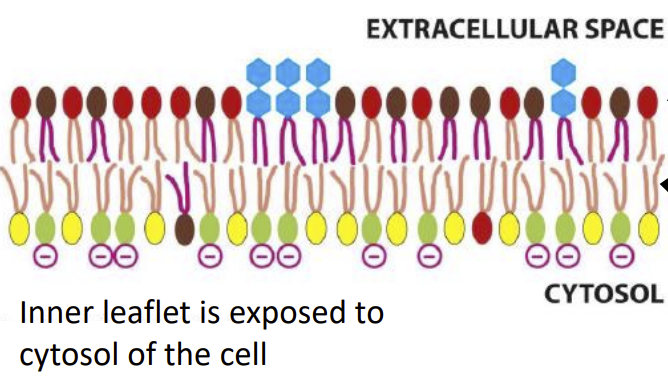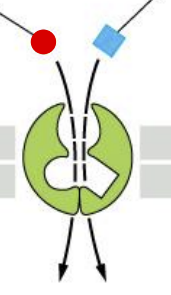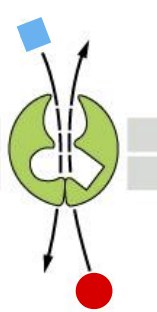Physio Lect 2 - Solute Transport through the Plasma Membrane
1/33
There's no tags or description
Looks like no tags are added yet.
Name | Mastery | Learn | Test | Matching | Spaced |
|---|
No study sessions yet.
34 Terms

This is the lipid bilayer, what is its use?
Controls the transport of molecules in and out of the cell.
Are the head groups or the fatty acid tails hydrophilic?
the head groups
Are the fatty acid tails in the lipid bilayer hydrophobic or hydrophilic?
hydrophobic
Rank these in terms of ease of transport through the lipid bilayer (easiest to hardest):
hydrophobic molecules (gases)
small uncharged polar molecules (water, urea, and glycerol)
ions
large, uncharged, polar molecules (glucose and sucrose)
hydrophobic molecules (gases)
small uncharged polar molecules (water, urea, and glycerol)
large, uncharged, polar molecules (glucose and sucrose)
ions
how do gases move through the lipid bilayer?
simple diffusion
how do small uncharged polar molecules move through the lipid bilayer?
can go through without aid of proteins, but often movement through bilayer is enhanced through transmembrane proteins creating channels through membrane - concentration difference (for water it would be Aquaporins)
how do hydrophilic solutes (Na+, K+, and glucose) pass through the membrane?
proteins pass through the cell membrane and create channels through the membrane - which then drives the molecules through simple diffusion
what is passive diffusion of ions?
when ions move from high conc to low conc (uses transmembrane protein called an ion channel)
can ion channels be considered as pores for the cell to allow molecules in and out?
yes
how many subunits compose an ion channel in general?
4-5 subunits
how do we tell these channels apart into their subtypes?
they can be repetitions of a single unit or be made up of many different protein subunits, thus making the channels different and distinguishable
Are ion channels selective?
yes
What determines selectivity?
pore size (Na+ is smaller than K+ - but hydration sphere is larger)
amino acid composition
What are the different types of ion channel gates?
Ligand gated
Voltage gated
Mechanically gated
Can there be non-gated ion channels?
yes - some channels are perpetually open
What is facilitated transport?
when a carrier protein transports a defined number of solutes from the extracellular to the intracellular space
how many conformational states do carrier proteins cycle through during facilitated transport?
two or more
what is facilitated transport proportional to?
the solute concentration at low concentrations
what is primary active transport?
when ATP hydrolysis is what drives transport
What is an example of active transport?
Na+-K+ ATPase-I
What happens during Na+-K+ ATPase-I active transport?
we consume 1 ATP per cycle
3 Na+ exit the cell
2 K+ enter the cell
In primary active transport, what is special about this pump?
it’s electrogenic
In Na+-K+ ATPase-I active transport, the transporter consumes about ______ of the cell’s energy
1/3
In Na+-K+ ATPase-I active transport, the transporter consumes about ______ of the NERVE cell’s energy
2/3
What do strong electrochemical gradients influence in cell physiology?
pH balance
osmotic balance
other transport mechanisms
What is the term for when active transport maintains the concentration and electrochemical gradient that serves as the driving force for passive transport, thus letting a second molecule/ion through?
Secondary Active Transport

uniport

symport

antiport
Provide an example of secondary active transport
Glucose Transporters driven by the Na+ Gradient
Glucose binds to a carrier protein that receives Na+ and glucose, using the electrochemical gradient for sodium the cell takes in the sodium ions and the glucose - using the energy to take in sodium as a way to take in glucose
What is the driving force of a channel?
electrochemical gradient
What is the driving force of facilitated transport?
concentration
electrochemical gradient
What is active transport?
energy driven transport against conc. gradient or electrochemical gradient
Transport of a molecule against its concentration gradient utilizing the high electrochemical gradient of Na+ developed by Na+/K+ ATPase is called…
secondary active transport